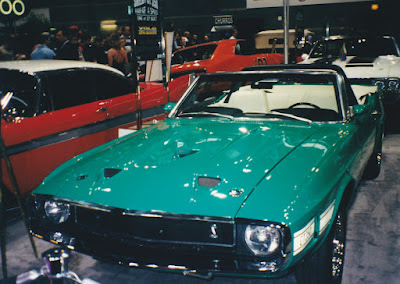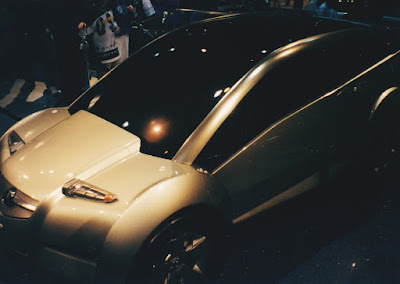Friday, June 11, 2021
Jeep Compass Concept
The Jeep Compass Concept made its debut at the 2002 North American International Auto Show in Detroit just weeks before appearing at the 2002 Chicago Auto Show where it is pictured here. Painted in a military-inspired color called Force Green, the Compass Concept was a 2-door crossover sport utility vehicle built on the new Jeep Liberty platform. Powered by a 210-horsepower 3.7-liter PowerTech™ V6 engine with 235 foot-pounds of torque mated to a four-speed automatic transmission, the Compass Concept could accelerate from 0 to 60 miles per hour in 9 seconds, cover a quarter-mile in 17 seconds, and reach a top speed of 110 miles per hour. The all-wheel-drive Compass Concept featured lightweight steel “uniframe” construction with a short wheelbase and a low center of gravity. Additional features included independent front suspension, multi-link rear suspension, dual exhaust, 19-inch performance wheels with red-line tires, and a spare tire incorporated into the rear hatch. The interior featured a molded rubber floor and four bucket seats trimmed in green leather and GORE-TEX® with G Force Green soft touch grommets. The rear buckets folded to create a flat loading surface in low-gloss stainless steel with integrated tie downs in the side trim. The Compass Concept was planned to have a target price under $20,000. A production Jeep Compass would be introduced for 2007, but it would be a four-door compact crossover SUV powered by a choice of inline four-cylinder engines with optional electronically-controlled four-wheel drive with a continuously variable transmission.
1958 Plymouth Fury "Christine"
This car appears to be a 1958 Plymouth Fury as featured in the film adaptation of Stephen King’s 1983 novel “Christine.” In both the novel and the film, Christine is described as a red and white 1958 Plymouth Fury, though in reality every 1958 Plymouth Fury was painted Sandstone White with anodized gold aluminum trim and a Buckskin Beige interior. The cars used in production of the film were Belvedere and Savoy models with the similar but more common trim of the Belvedere. It is unclear if this car, displayed by the Volo Auto Museum at the 2002 Chicago Auto Show, is one of the cars used in the making of the film or is merely a replica.
1969 Shelby GT350 Convertible
In 1965, Carroll Shelby introduced the Shelby GT350 version of the
Ford Mustang fastback coupe, powered by a 306-horsepower high-performance
version of Ford’s 289-cubic-inch Windsor small-block V8 with a high-rise intake
manifold, a large four-barrel Holley carburetor, a Borg-Warner T-10 four-speed
gearbox, and other performance upgrades. Convertibles were first offered for
1968. The last of the original generation of Shelby Mustangs were built for
1969, though a few hundred leftover cars were given 1970 serial numbers and
minor cosmetic changes. The 1969 Shelby GT350 was powered by Ford’s new
290-horsepower 351-cubic-inch Cleveland V8 engine. This convertible was
displayed at the 2002 Chicago Auto Show by the Volo Auto Museum.
1970 Oldsmobile 4-4-2 Convertible Indianapolis 500 Pace Car
The Oldsmobile 4-4-2 was introduced in 1964 as an options package for the intermediate-sized Oldsmobile F-85 and Cutlass, consisting of, among other things, a 4-barrel carburetor, a 4-speed manual transmission, and dual exhaust. The 4-4-2 became a distinct model in, and reached a performance peak in 1970 when the 455-cubic-inch “Rocket” V8 engine became the standard 4-4-2 engine with 365 horsepower and 500 foot-pounds of torque, and an available W-30 option package that offered an increase to 370 horsepower. The 1970 Oldsmobile 4-4-2 Convertible was selected as the pace car for the 1970 Indianapolis 500, with the optional W-25 fiberglass hood and painted in porcelain white with black and red stripes on the sides and on top from the hood to the deck lid and white Super Stock II wheels. Oldsmobile offered the Y74 option package to replicate the pace car for both the 4-4-2 and the Cutlass Supreme. A total of 626 Y74 Indianapolis 500 Pace Car Convertibles were produced, with 268 being the 4-4-2 model, and the remaining 358 being Cutlass Supremes, 60 of which were powered by the 310-horsepower “Rocket” 350-cubic-inch V8 engine instead of the 455. This 1970 Oldsmobile 4-4-2 Indianapolis 500 Pace Car Convertible was displayed at the 2002 Chicago Auto Show by the Volo Auto Museum.
1969 Dodge Charger "General Lee"
Introduced in 1966, the Dodge Charger had been redesigned for 1968
and therefore saw only minor changes for 1969. Engine choices ranged from the
145-horsepower 225 “Slant Six” to a variety of V8 options, including the
230-horsepower 318, 290-horsepower 2-barrel and 330-horsepower 4-barrel 383s,
the 375-horsepower 440 “Magnum” and the 425-horsepower 426 “Hemi.” The 1969
Charger’s place in popular culture was cemented by its role as the orange
“General Lee” race car, driven by John Schneider and Tom Wopat as Georgia
cousins Bo and Luke Duke on the television series “The Dukes of Hazzard” from
1979 to 1985. A highlight of the show was the numerous jumps and other stunts
performed by the “General Lee,” with the number of Chargers destroyed by the
production reaching into the hundreds of cars, to the point that some 1968
Chargers were disguised as 1969 models for use on the show, and in later
seasons the show resorted to reusing old footage and even using radio-controlled
model cars for new jump scenes. This example, displayed by the Volo Auto Museum
at the 2002 Chicago Auto Show, was apparently a promotional car owned by
General Lee Enterprises. Though not used on screen, it was used in tours to
promote the show, and when it was retired it was autographed by many of the
cast members. Today, the Volo Auto Museum has a different “General Lee” in its
collection that was one of the original cars built for the show.
Chrysler Pacifica Concept
The Chrysler Pacifica Concept debuted at the 2002 North American International Auto Show in Detroit just weeks before appearing at the 2002 Chicago Auto Show where it is pictured here. Described by Chrysler as a “sports tourer,” the Pacifica Concept was a crossover SUV featuring a low step-in height, three-row seating, and car-like handling. Powered by a 250-horsepower 3.5-liter single overhead cam 24-valve V6 engine with a four-speed AutoStick® automatic transmission and featuring on-demand all-wheel drive or front-wheel drive with traction control, independent front and independent load-leveling rear suspension, four-wheel anti-lock brakes, 19-inch satin silver aluminum wheels, a tire pressure monitoring system, and a 400-mile cruising range. Interesting features included solenoid-operated door handles, an industry-first power liftgate, and a glass skylight running the full length of the roof, creating an open, welcome feel and giving passenger a panoramic view of the outside world. The Pacifica Concept featured three rows of leather-trimmed memory seats with lumbar and thigh support and side curtain air bags for all three rows, including a heated 10-way power driver’s seat, a heated 4-way power front passenger seat, heated second row bucket seats with fore-aft, recline and fold-flat capability, and third row 50/50 fold-flat bench, and a continuous full-length center console with dual cup holders, adjustable air outlets and a storage area, and seat-mounted armrests for the first and second row seats, power adjustable pedals, satellite radio, a comprehensive memory system for the radio, driver seat, mirrors and pedals, leather-wrapped steering wheel and shifter, wood and satin silver interior accents, ignition switch on the instrument panel, integrated in-dash thin film transfer display navigation system, hands-free cellular phone communication, vehicle immobilizer, security alarm system, dual zone automatic temperature control with odor/particulate filtration and a flip-down roof-mounted DVD screen is available to rear seat occupants with a theater-style surround sound audio system with eight Infinity® speakers. Production of the Chrysler Pacifica began in early 2003 as a 2004 model with few changes from the concept.
Mercury Marauder Convertible Concept
First seen as a concept car at the 1998 Specialty Equipment Market
Association (SEMA) show in Las Vegas, Nevada, the Mercury Marauder 4-door sedan
would be introduced in the summer of 2002 as a 2003 model. Named after the
original Mercury Marauder introduced in 1963, tihs new version was a
high-performance variant of the Mercury Grand Marquis, powered by a
300-horsepower 4.6-liter double-overhead cam V8 with 300 foot-pounds of torque
with a 4-speed automatic transmission, 3.55:1 rear end, a performance
suspension, and 18-inch wheels with high-performance tires. As the release of
the production Marauder approached, Mercury debuted a new concept for a
5-passenger 2-door convertible version of the Marauder, made possible by a
newly-fortified frame for the new 2003 production models. In addition to the
new body style, the Marauder Convertible Concept also featured a supercharged
version of the 300-horsepower 4.6-liter double-overhead cam V8 producing 355
horsepower and 355 foot-pounds of torque, a lowered suspension and a
power-operated roof that was stored under a hard tonneau cover.
2002 Acura NSX
The hand-built, mid-engined, aluminum-bodied Acura
NSX had been redesigned for 2002, as seen here at the 2002 Chicago Auto Show,
and featured a 290-horsepower 3.2 Liter aluminum-alloy 24-valve DOHC V6 with
244 ft-lbs of torque, Honda's Variable Valve Timing & Lift Electronic
Control (VTEC) system, titanium connecting rods, and an 8,000-RPM redline, a
6-speed manual transmission, 4-wheel independent aluminum double-wishbone
suspension & ventilated ABS disc brakes, 17-inch alloy wheels and traction
control. Additional standard features included a Drive-by-Wire throttle system,
a removable aluminum roof-panel with on-board storage, automatic climate control,
an Acura/Bose® music system, a perforated leather-trimmed interior with 4-way
power driver’s & passenger’s seat adjustment, and xenon high-intensity discharge
(HID) projector-beam headlights.
Acura RD-X Concept
The Acura RD-X Concept debuted at the 2002 North American International Auto Show in Detroit just weeks before appearing at the 2002 Chicago Auto Show where it is pictured here. The concept was designed and developed by Honda Research & Development Americas combining characteristics of the RSX sports coupe and the MDX sport utility vehicle, featuring a compact body styled with a raked beltline and wheel flares. The RD-X concept was designed with a 250-horsepower 4-wheel drive hybrid powertrain consisting of a high-output 2.4-liter 16-valve double overhead cam 4-cylinder i-VTEC™ engine with a Formula One-inspired computer-controlled 6-speed, close-ratio clutchless manual transmission with a paddle shifter on the center console driving the front wheels, and an advanced Integrated Motor Assist (IMA) system with twin electric motors powering the rear wheels when extra power or traction is required, increasing power and distributing torque in a similar way to an all-wheel drive sport utility vehicle. The RD-X Concept also featured fully independent front and rear suspension, 4-wheel disc brakes, 18-inch wheels with run-flat tires and retractable headlights. The driver-oriented cockpit featured fixed dual front bucket seats trimmed in durable, high-tech fabric, adjustable instruments, steering wheel and pedals, rear-facing cameras in place of side view mirrors that transmit to displays mounted on the steering column, and a heads-up display projecting the speed, fuel level, and other warnings onto the windshield, along with the Acura Satellite-Linked Navigation System. The rear seats were angled outwards for increased legroom and could be folded forward and stowed for additional cargo room. Without a B-pillar, the side doors opened outward from the center like “suicide doors” to provide a large opening into the vehicle. Instead of an upward swinging hatch at the rear, a pair of powered doors slid open to hug the sides for easy access in tight quarters to the rear cargo area, which featured a low flat floor, built-in floor brackets to secure bicycles, and a hidden storage area in the side panel. The RD-X Concept also featured a glass roof with a portion at the rear that opened to allow transport of items too large or tall to fit in the enclosed cargo area. A far more conventional production RDX model was introduced for the 2007 model year.














